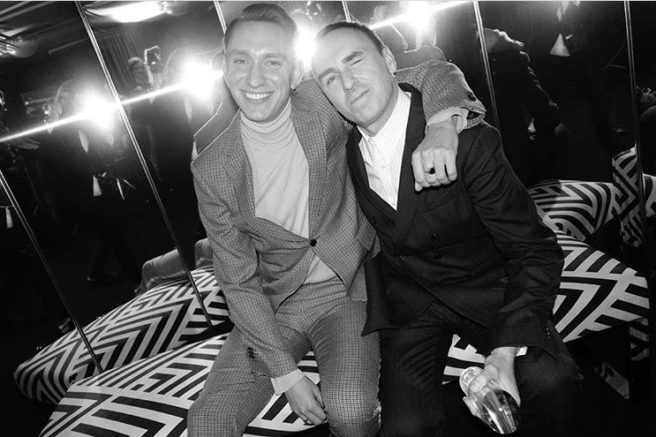Wanderful Loves
“International Man of Mystery” was the heading, in Wallpaper Magazine, of a wildly enthusiastic article about Casimir, a designer as special as he is distinguished. And even though he prefers ‘furniture maker’ to designer, his oeuvre speaks for itself. In the twenty-five years that Casimir has been making furniture, he has worked his way up to master in contemporary design, with craftsman-made oak furniture. He has continued to plane his style and his designs, with an unfailing individuality. Casimir’s master signature is embodied in an oeuvre which is both solid and delicate.
“Casimir is someone who appears and disappears”, you’ll hear them sometimes say, in the circle of design afficionados who have been following him since the beginning. He graduated in Industrial Design from Genk, in 1992, with a thesis titled There are many ways, but there is no Rome. A harbinger of the permanent quest he was to develop during his career. The man has certainly had his highs and lows. “When I first started, with the few tools I had then, wood was the only thing I could work well with. Solid wood demands a lot of manual labour, but I had plenty of time”, he said at the time. However, Casimir has never renounced wood. A good example of his poetic craftsman-like skill is the Schaal n°1. He has been making this solid wood object – somewhere between a table and a bowl – for more than twenty five years, and still it has lost none of its mesmerising beauty.
CULTURE PRIZE
The designer had soon developed his own design language. For example, at INTERIEUR ’92, the Kortrijk design biennial in 1992, Casimir introduced two furniture projects. There were immediately included in a new collection of Belgian design, put together by Ziggurat, an illustrious Gent ‘Gallery of individualistic furniture objects’, which at the time, was trying to launch its own line, with works from ten designers. Incidentally, that collection also included furniture by Christian Kiekens and Dirk Meylaerts, and fellow student Raf Simons. Even then, the young Casimir’s work stood out. Not that it already had the stature, enormity and massiveness that so characterises his later work.
Casimir’s skills did not go unnoticed. In 1994, he received the Cultuuronderscheiding (Culture Prize) from the Provincie Limburg, even though his furniture collection was not yet rooted in a professional structure. “I soon encountered the boundaries of the possibilities, and the limits of the procedure. There was no professional production, and logistically it was improvised. And I made rather large, solid wood furniture which needed to be treated carefully. Transport meant watching out for any damage, the influence of changing climatological conditions and therefore meant a high entry-level cost. Potential dealers aren’t just going to purchase a collection costing between 10,000 and 15,000 Euros, which also takes up an awful lot of room.”
VLAEMSCH ( )
In 1995, Casimir started his own design studio, in which he focussed on commissioned interior, graphic and industrial design, in addition to the craftsman’s furniture collection. In an interview with Weekend Knack, in 2001, Casimir explains it as follows: “I wanted to try and live from my furniture. I actually made a mistake with that. I had a number of sales outlets who thought my work was good. Those people supported the work, but they also came questions. I had refurbished a restaurant in Hasselt, including making a table. A buyer then asked if I could make that table for him too, because he would be able to sell something like that easily. It was pure project furniture, it had nothing to do with my design language. But I let myself be talked into it. After all, I had to earn my living. Every now and then, I fall for things like that.” Nonetheless, in 2000, his company received the Henry van de Velde Prize for ‘Best Business’. Casimir was on the right track, but it wasn’t in his nature to blindly charge along in the same direction, and apart from anything else, the business troubles started to hinder him.
“I need a new challenge every three or four years”, says the affable Limburg man. He was constantly working on new ideas, and one of them matured into a new project: a label which enabled products to be industrialised without them being subject to the material restrictions as was the case with his furniture. It was to be called Vlaemsch ( ). Vlaemsch ( ) was to be everything Casimir couldn’t be: industrial instead of craftsman-like, conquering the market instead of passively waiting for the customers to come. Moreover, it was to present a range of products with a competitive, fair price, offering products which everyone needs, supplemented with carefully-chosen accessories.
MARKET-CONQUERING
Although there was an ‘avant-première at ‘Hasselt showt smaak’, Casimir saved the real christening of Vlaemsch ( ) for INTERIEUR 04. ‘Simplicity, level-headedness, a touch of surrealism, and quality too, those are the keywords of Vlaemsch’, was reported in the national press, which was clearly not yet ready for the obligate parentheses of the logo. The items exhibited included: the Annual chair – a slice of a birch trunk as a seat – by Leon Ransmeier, Saskia Marcotti’s almost iconic Bootbag, the Deer-hertenkop, made of birch plywood by Augustin Scott de Martinville, now enjoying success with Big Game.
“The response was very positive, but after Interieur came disillusion”, Casimir remembers. “One of the initial investors withdrew from the plan, saying he had no understanding of the unmeasurable culture product, and saw no other examples on which to base himself. He was afraid of the risk, and because we couldn’t replace him quickly, the other two investors withdrew as well.” Vlaemsch ( ) imploded just as it was about to go public at the Milan design week. “I was forced to cancel the presentation. I was all alone, with a premature baby which everyone thought was very beautiful, but which turned out not to be viable.” Vlaemsch ( ) had hooked its barbs into Casimir.
IMPLOSION
After a break of four years, Casimir seemed for the first time to be picking up Casimir Meubelen again in 2008 and 2009; the company had been restyled and given a new logo. Poutrel, Kist, Zak and Ladder, as the pieces were called, proved without a doubt that Casimir still had it in him. And yet, he was still plagued by business troubles.
“My company went bankrupt in 2010”, he says, pointing to Licensed, “It was a limited company that acted as an umbrella for everything I made for Casimir Meubelen, and also Vlaemsch ( ), the design business that is best described as a sort of ‘prêt-à-porter’ collection of design items. My own work was separate from that; the ‘haute couture’, you might say.” Taking a fall happens when you lose control of things, but Casimir insists there were no reckless manoeuvres before the bankruptcy. At least, not by his own hands. “My biggest problem was being mistaken in the people, and of course, I made my own mistakes too”, he says. “I’m not trying to dodge my responsibility. But the biggest mistake of my life was founding Vlaemsch ( ).”
“I was determined, that’s for sure. It was to be everything that Casimir couldn’t be: industrial instead of craftsman-like, market-conquering instead of the passive approach. I think I must have had too much testosterone at the time.” His down-to-earth attitude make it clear: he’s done with it. All of it. “How could I have believed so blindly in it? How could I think that I had to do something which is the exact opposite of who I am and what I stand for? I don’t know. I made a huge mistake. And let myself down.” It remains undeniably connected to his career; however, while one might welcome guts and entrepreneurship from an American mentality – there’s that wonderful quote from the former opera star, later manager of the New York City Opera Beverley Sills, who said, “If you fail, you might be disappointed, but you’re doomed if you don’t try.” – in Flanders, the image of the failure dominates all too often. Like a cat with nine lives, Casimir still manages to keep starting up new projects. He has however learned his lesson. “I’m a furniture maker. I’m not a designer; I’m not interested in design, or what they’ve been calling design for the last decade.”
SUBVERSIVE
As a furniture maker, Casimir has always had a subversive streak; it’s what made him who he is, and because of that, he’s made his opportunities. Not been given, but made them. His oeuvre arose from a metier, from a modus operandi which embodies the soul of a craftsman. Casimir’s unconventional furniture is driven by the honesty of the construction and the material, and just like the large furniture pieces by designers such as Maarten van Severn or Dirk Meylaert, every single piece is made without any form of structural support. That oeuvre stands, and will never lose its value. The great thing is that he continues to work, with even more conviction, and his studio on the outskirts of Antwerp offers him enough space to do so.
“Casimir is an artistic genius, a true craftsman who also has a nose for young talent,” confided the CEO of a Limburg design manufacturer to me once. “The man has a track record. And no, it hasn’t always been all that pretty, or successful, but the designer will always prevail. As a furniture maker, he ranks among the best in the world,” All design connoisseurs agree. Casimir stands for authenticity, and there’s always an undertone, a certain irony – some even say Belgian realism à la René Magritte en Marcel Broothaers. Maybe one day he will be called the standard-bearer for what could be regarded as a Flemish style: sincere, down-to-earth and solid. There have been earlier comparisons made with a Brabants shire horse, or the Mechelse Cuckoo, but Casimir is already a Flemish Giant.


